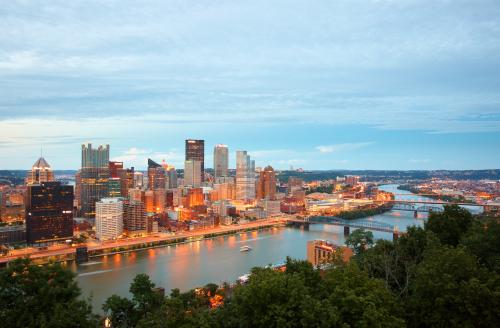There’s growing evidence of rapidly spreading income and opportunity divides between the dynamic, growing metropolises of America’s East and West coasts and the Heartland in between.
Yet there is a third U.S. coast, a “freshwater coast” along the more than 10,000 miles of Great Lakes shoreline, that is proving to be an important fulcrum for economic renewal in America’s interior. Continued federal efforts are especially critical for securing the future of many smaller communities that line that coast.
As documented in prior posts, heavy industry along the Great Lakes shores and rivers of the region powered the Midwest’s economic growth. Green Bay, Wis. grew as a paper mill town, fouling the Fox River as it entered Lake Michigan. Across the lake in Muskegon, Mich., paper mills, chemical plants, and auto parts plants turned spectacular Muskegon Bay into a toxic hotspot. Duluth, Minn.’s waterfront was an industrial port, where the Front Range’s iron ore was shipped to Marquette across Lake Superior and on to the steel mills abutting the Great Lakes in Gary, Ind., Cleveland, and Buffalo.
The use and abuse of these waters to power the region’s steel, car, chemical, and paper industries reached a zenith in 1969 when four Great Lakes tributaries were so fouled that they caught fire (the Buffalo, Chicago, and Rouge rivers near Detroit, as well as the more infamous Cuyahoga River in Cleveland). Love Canal outside Niagara Falls, N.Y. became synonymous with environmental catastrophe. At the time, Lake Erie was famously pronounced “dead” in national publications. The vivid abuse of Great Lakes waters spurred the nation’s environmental movement and the passage of the Clean Water Act.
Since then, both the economy and condition of the Great Lakes has changed. An urbanizing, technology-driven services economy has replaced the belching factories of yesteryear. Many factories, plants, and port facilities on the water became redundant, leaving behind a riot of detritus from the industrial era, including 31 toxic national areas of concern in the water.
Facing this cycle of change, many communities in the region initiated public-private partnerships to clean up the mess from the industrial era, reconnect downtowns to formerly industrial riverfronts and lakefronts, and create new amenity options. More than a dozen years ago, Milwaukee organized around water as its new brand. Building on what Mayor Tom Barrett calls Milwaukee’s water “magic,” the city fueled clean-tech water business growth, expanded water research and education centers, and developed cultural institutions, entertainment, and recreation venues along the cleaned-up Milwaukee River and Lake Michigan shores. In Detroit, the Riverfront Conservancy has redeveloped miles of former industrial waterfront for strolling, biking, and festival events, with old factories remade as lofts and offices. In Traverse City, Mich., the waterfront cherry canneries are long gone, and Lake Michigan’s beautiful Grand Traverse Bay is attracting year-round professionals in residence as well as tourists.
The federal government has played an important role in these efforts. Encouraged in part by a 2007 Brookings study predicting a 3-to-1 economic impact for every dollar invested in Great Lakes cleanup, Congress and President Obama approved funding for the Great Lakes Restoration Initiative (GLRI), beginning in 2009. Since then, the federal government has spent over $2.3 billion on more than 3,500 projects along the 10,000 miles of Great Lakes freshwater coastline. Projects (documented in an interactive EPA map) have cleaned toxic hot spots, redeveloped wastewater systems, restored harbors and waterfronts, protected and reconstituted vital wetlands and fish habitats, reduced invasive species, curbed nutrient runoffs, and improved overall water quality.
For many Rust Belt communities that aren’t home to a major metro area or anchored by one of the region’s world-class universities, Great Lakes restoration is bolstering their economic standing. Only 67 counties out of 504 total—one in eight—in Wisconsin, Illinois, Michigan, Indiana, Ohio, and Pennsylvania today have higher per capita incomes than their statewide average. By comparison, one in five (15 of 70) counties in these same states that touch a Great Lake boast above-average incomes. They include four of the nine high-income counties in Michigan, four of 11 in Wisconsin, four of 16 in Ohio, and two of four in Illinois.

Three of these 15 counties are part of a major metro area—Cuyahoga, Ohio (Cleveland) and Cook and Lake in Illinois (Chicago and its lakefront suburbs)—in which redeveloped lakefronts are contributing to their appeal and growth. The rest of the Great Lakes’ high-income coastal communities are smaller historical places sitting on some special real estate, where the ability to enjoy the water for strolling, boating, and birding, or just to watch a sunset or sunrise from an office, home, or restaurant pays an economic dividend.
A rigorous economic impact of the GLRI spending is now underway coordinated by the Council of Great Lakes Industries and the Great Lakes Commission. But the connection of the region’s people to the Great Lakes, and their enjoyment of its newly clean and accessible waters, may explain the strong and successful bipartisan pushback to date against the Trump administration’s efforts to zero out the GLRI.
In that sense, the pull and magic of the Great Lakes and freshwater coast may be one of the few things more powerful than today’s polarized politics.
Lucas Arbulu contributed to this post.






Commentary
The nation’s freshwater coast is a key fulcrum for Rust Belt revival
May 31, 2018